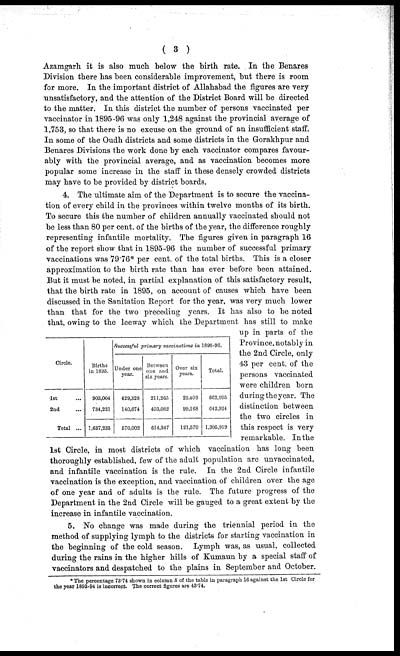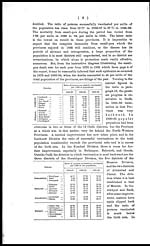Medicine - Vaccination > 1866-1901 - Annual report upon vaccination in the North-Western Provinces > Vaccination North-Western Provinces and Oudh 1896-1901 > 1895-1896 - Annual report on vaccination in the North-Western Provinces and Oudh for the year 1895-96
(71) Page 3
Download files
Individual page:
Thumbnail gallery: Grid view | List view

( 3 )
Azamgarh it is also much below the birth rate. In the Benares
Division there has been considerable improvement, but there is room
for more. In the important district of Allahabad the figures are very-
unsatisfactory, and the attention of the District Board will be directed
to the matter. In this district the number of persons vaccinated per
vaccinator in 1895-96 was only 1,248 against the provincial average of
1,753, so that there is no excuse on the ground of an insufficient staff.
In some of the Oudh districts and some districts in the Gorakhpur and
Benares Divisions the work done by each vaccinator compares favour-
ably with the provincial average, and as vaccination becomes more
popular some increase in the staff in these densely crowded districts
may have to be provided by district boards.
|
Circle. |
Births |
Successful primary vaccinations in 1895-96. |
|||
|
Under one |
Between |
Over six |
Total. |
||
|
1st ... |
903,004 |
429,328 |
211,265 |
22,402 |
662,995 |
|
2nd ... |
734,231 |
140,674 |
403,082 |
99,168 |
642,924 |
|
Total ... |
1,637,235 |
570,002 |
614,347 |
121,570 |
1,305,919 |
4. The ultimate aim of the Department is to secure the vaccina-
tion of every child in the provinces within twelve months of its birth.
To secure this the number of children annually vaccinated should not
be less than 80 per cent. of the births of the year, the difference roughly
representing infantile mortality. The figures given in paragraph 16
of the report show that in 1895-96 the number of successful primary
vaccinations was 79.76* per cent. of the total births. This is a closer
approximation to the birth rate than has ever before been attained.
But it must be noted, in partial explanation of this satisfactory result,
that the birth rate in 1895, on account of causes which have been
discussed in the Sanitation Report for the year, was very much lower
than that for the two preceding years. It has also to be noted
that, owing to the leeway which the Department has still to make
up in parts of the
Province, notably in
the 2nd Circle, only
43 per cent. of the
persons vaccinated
were children born
during the year. The
distinction between
the two circles in
this respect is very
remarkable. In the
1st Circle, in most districts of which vaccination has long been
thoroughly established, few of the adult population are unvaccinated,
and infantile vaccination is the rule. In the 2nd Circle infantile
vaccination is the exception, and vaccination of children over the age
of one year and of adults is the rule. The future progress of the
Department in the 2nd Circle will be gauged to a great extent by the
increase in infantile vaccination.
5. No change was made during the triennial period in the
method of supplying lymph to the districts for starting vaccination in
the beginning of the cold season. Lymph was, as usual, collected
during the rains in the higher hills of Kumaun by a special staff of
vaccinators and despatched to the plains in September and October.
* The percentage 73.74 shown in column 5 of the table in paragraph 16 against the 1st Circle for
the year 1893-94 is incorrect. The correct figures are 43.74.
Set display mode to: Large image | Zoom image | Transcription
Images and transcriptions on this page, including medium image downloads, may be used under the Creative Commons Attribution 4.0 International Licence unless otherwise stated. ![]()
| Permanent URL | https://digital.nls.uk/87228641 |
|---|
| Attribution and copyright: |
|
|---|




